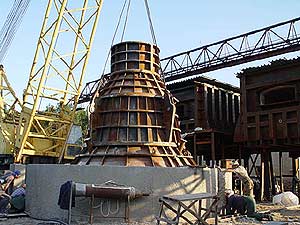 |
'Most sonorous' bell of all Russia is recast (35 tons)One of our suppliers, Vera LLC, has cast a 35 metric (38.5 US) ton bell at its foundry in Shilova, a few kilometers from Voronezh. The bell is 365 cm in diameter; 370 cm in height, and is composed
of 19.25% tin, 81.75% copper, without impurities. Its clapper is
3 meters (10 feet) long, and weighs about 1 ton, and its strike
tone is B flat. The bell is embellished with 20 icons. When the foundry was preparing to cast the bell, a miraculous sign
appeared— two crosses of cloud suddenly formed in the clear
blue sky and persisted above the furnaces for some time before eventually
dissipating. Awestruck and greatly encouraged, the foundrymen set
about their tasks with the feeling that their enterprise had indeed
received the blessing of God. The new bell is to replace the festal blagovestnik— the main bell— of the Savvino-Storozhevsky Monastery in Zvennigorod, which for 350 years was considered to be the most sonorous in all of Russia. However, when the Nazis approached Moscow in the autumn of 1941,
it was decided to remove the bell from its tower and to hide it
in the Moscow River. Unfortunately, during removal, it fell and
broke. Zvennigorod’s new bell is now the largest in Russia, exceeding
by a couple of tons even the 31.5 metric (34.7 US) ton bell recently
cast for Trinity-Sergius Lavra. It is larger than America’s
largest, the 32-ton Peace Bell in Cincinnati, as well. The monastery itself was founded some 600 years ago and is therefore one of Russia’s oldest and most venerable. The name of the town that surrounds it, “Zvennigorod”, means “Ringing City” because its bells, and particularly this one, could be heard even in Moscow, some 30 miles away— in fact they functioned for centuries as Moscow’s distant early warning system. While that would no longer be the case because of population growth
and noise pollution, it’s still worth noting what the late
master zvonar Vladimir Ivanovich Mashkov once said about it: “We
were as if rooted to the ground. It was like the sound of the ocean
washing over us.” The most difficult problem for Vera was not just to make a 35-ton bell— though more about that in a moment— but to produce a bell with a voice just like that of the original. Fortunately, Konstantin Saradjev, a famous bell musician who lived at the turn of last century, just before electronic recording devices were invented, studied this bell along with thousands of others and, using a method he had devised for indicating all the tones of a bell and their durations, he was able to make detailed notes from which Vera and Nunin of AKIR were able to reconstruct the shape and sound of the original. The largest bell Vera had previously cast was a 6-ton blagovestnik for Annunciation Cathedral in Voronezh. Obviously, the Zvennigorod bell was on a completely different scale: The steel bracing which supported the clay mould itself weighed 80 metric (88.1 US) tons. Three days and 7 metric tons (7.7 US tons) of alcohol were consumed in firing the mould. 45 tons of tin and copper were smelted to make enough bronze available for the casting itself. The foundry had to develop a special triple mobile furnace to ensure that no gaps or bubbles would ruin the pour. When they finally poured the bronze, it took 27 minutes to fill the mould at the rate of more than a ton of moulten metal per minute. After casting, it took a full week for the bell to cool down, and after it had done so, the mould was broken and the bell was milled with a special precision machine developed by Anatoli Vasilievich Strukov, a tower-clock master from Voronezh noted in the Guiness Book of Records for having made a the world’s only 1.5 meter diameter tower clock with a second hand. Moving the bell to the monastery— 12/25/03— The bell was transported to the monastery in December 2003, in time for Christmas. It was brought there by a truck originally intended for hauling ballistic missiles.
What lies ahead? Vera is now planning to cast a 60-ton bell.
|
 |
|
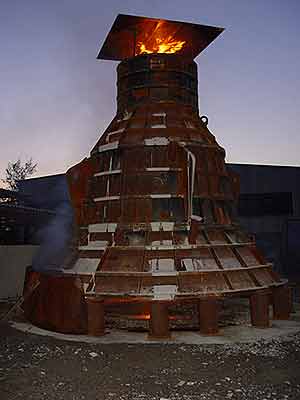 |
|
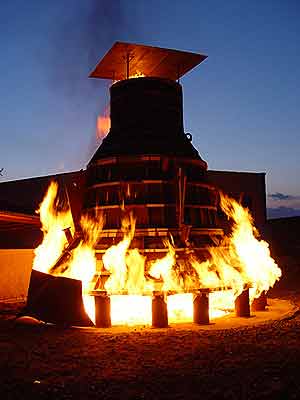 |
|
 |
|
 |
|
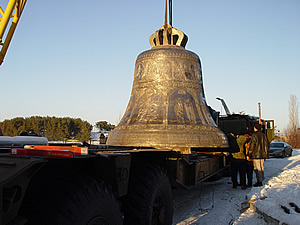 |
|
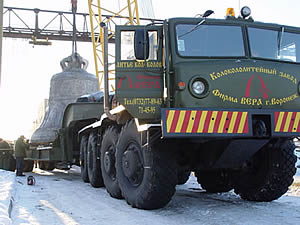 |
|
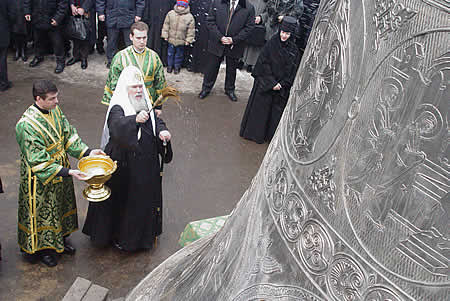 |